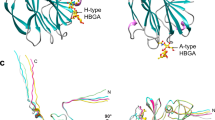Abstract
Rotaviruses are the major etiologic agents of acute gastroenteritis. Viral attachment to the cell surface is crucial to initiate infection. The VP8∗ domain, the trypsinized cleavage fragment of the outermost spike protein VP4 of rotavirus, has a galectin-like structure required for binding to the cell surface. We used the evanescent-field fluorescence-assisted assay to understand the complex mechanism underlying the virus-glycan/glycoprotein interaction. Besides, we have described virus infection assays, neutralization assay, and pretreatment assay, using cell culture. These approaches using rotavirus particles will provide novel information that has been difficult to obtain from glycan microarray using recombinant VP8∗.
Access this chapter
Tax calculation will be finalised at checkout
Purchases are for personal use only
Similar content being viewed by others
References
Desselberger U (2014) Rotaviruses. Virus Res 190:75–96
Greenberg HB, Estes MK (2009) Rotaviruses: from pathogenesis to vaccination. Gastroenterology 136:1939–1951
Baker M, Prasad BVV (2010) Rotavirus cell entry. In: Johnson J (ed) Cell entry by non-enveloped viruses, Current topics in microbiology and immunology, vol 343. Springer, Heidelberg, pp 121–148
Dormitzer PR, Sun ZY, Wagner G et al (2002) The rhesus rotavirus VP4 sialic acid binding domain has a galectin fold with a novel carbohydrate binding site. EMBO J 21:885–897
Hu L, Crawford SE, Czako R et al (2012) Cell attachment protein VP8∗ of a human rotavirus specially interacts with A-type histo-blood group antigen. Nature 485:256–259
Pang LL, Wang MX, Sun XM et al (2018) Glycan binding patterns of human rotavirus P[10] VP8∗ protein. Virol J 15:161. https://doi.org/10.1186/s12985-018-1065-9
Kim HS, Lee B, Han SY et al (2017) Expression of bovine rotavirus VP8 and preparation of IgY antibodies against recombinant VP8. Acta Virol 61:143–149
Dunn SJ, Fiore L, Werner RL et al (1995) Immunogenicity, antigenicity, and protection efficacy of baculovirus expressed VP4 trypsin cleavage products, VP5∗ and VP8∗ from rhesus rotavirus. Arch Virol 140:1969–1978
Matthijnssens J, Ciarlet M, McDonald SM et al (2011) Uniformity of rotavirus strain nomenclature proposed by the Rotavirus Classification Working Group (RCWG). Arch Virol 156:1397–1413
Inagaki M, Muranishi H, Yamada K et al (2014) Bovine k-casein inhibits human rotavirus (HRV) infection via direct binding of glycans to HRV. J Dairy Sci 97:2653–2661
Nakagomi O (2016) Title of Fundamentals of ultracentrifugal virus purification. https://ls.beckmancoulter.co.jp/files/cases/Fundamentals_of_Ultracentrifugal_Virus_Purification.pdf. Accessed 28 May 2019
Kuno A, Uchiyama N, Koseki-Kuno S et al (2005) Evanescent-field fluorescence-assisted lectin microarray: a new strategy for glycan profiling. Nat Methods 2:851–856
Acknowledgments
We appreciate Dr. Osamu Nakagomi, Dr. Toyoko Nakagomi, Dr. Makoto Sugiyama, and Dr. Naoto Ito for their contribution in describing the virus purification. This work was supported by the Japan Society for the Promotion of Science [JSPS, Tokyo, Japan; Grant-in-Aid for Scientific Research (C) no. 17K08398 (to K.Y.) and 18K05504 (to M.I.)].
Author information
Authors and Affiliations
Corresponding author
Editor information
Editors and Affiliations
Rights and permissions
Copyright information
© 2020 Springer Science+Business Media, LLC, part of Springer Nature
About this protocol
Cite this protocol
Yamada, K., Nio-Kobayashi, J., Inagaki, M. (2020). Screening for Components/Compounds with Anti-Rotavirus Activity: Detection of Interaction Between Viral Spike Proteins and Glycans. In: Hirabayashi, J. (eds) Lectin Purification and Analysis. Methods in Molecular Biology, vol 2132. Humana, New York, NY. https://doi.org/10.1007/978-1-0716-0430-4_50
Download citation
DOI: https://doi.org/10.1007/978-1-0716-0430-4_50
Published:
Publisher Name: Humana, New York, NY
Print ISBN: 978-1-0716-0429-8
Online ISBN: 978-1-0716-0430-4
eBook Packages: Springer Protocols




